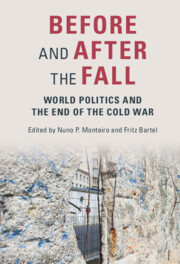Book contents
- Before and After the Fall
- Before and After the Fall
- Copyright page
- Dedication
- Epigraph
- Contents
- Figures
- Tables
- Contributors
- Preface
- Introduction
- Part I Sources of Continuity and Change
- Part II Continuity and Change Across the 1989/1991 Divide
- 6 The Nuclear Age
- 7 Legitimating Primacy After the Cold War
- 8 Russia’s Rejection of Liberal Politics
- 9 Continuity and Change in Russian Grand Strategy
- 10 The Stickiness of Strategy
- 11 Avoiding the Limelight
- Part III Toward a New World Order?
- Index
11 - Avoiding the Limelight
Deng Xiaoping and China’s Policy Toward the United States, 1989–1991
from Part II - Continuity and Change Across the 1989/1991 Divide
Published online by Cambridge University Press: 02 December 2021
- Before and After the Fall
- Before and After the Fall
- Copyright page
- Dedication
- Epigraph
- Contents
- Figures
- Tables
- Contributors
- Preface
- Introduction
- Part I Sources of Continuity and Change
- Part II Continuity and Change Across the 1989/1991 Divide
- 6 The Nuclear Age
- 7 Legitimating Primacy After the Cold War
- 8 Russia’s Rejection of Liberal Politics
- 9 Continuity and Change in Russian Grand Strategy
- 10 The Stickiness of Strategy
- 11 Avoiding the Limelight
- Part III Toward a New World Order?
- Index
Summary
Using previously untapped Chinese sources, this chapter builds on recent scholarship to provide additional insight into Deng Xiaoping’s handling of relations with the United States in the wake of the Tiananmen crackdown of June 1989. Confronted with the fall of communism in Eastern Europe and the Soviet Union as well as with Western sanctions, Deng had the tough job of balancing between conservatives and reformers in China’s leadership circle. Unlike the conservatives, who were ascending, and who blamed the United States for all of China’s troubles and would not have hesitated to break relations with Washington, Deng wanted to “keep the US door open.” But at the same time, Deng did not want to show any softness in dealing with Washington. Deng’s foreign policy directive, “avoiding the limelight, and getting some things done,” saved communist rule in China. After three years of dedicated diplomacy, China gradually broke Western sanctions and regained international acceptance, including a White House welcome for the Chinese foreign minister Qian Qichen. Had the Bush administration been tougher on China after the Tiananmen crackdown, it might have delayed China’s economic rise, but it wouldn’t have brought down the Chinese communist regime.
- Type
- Chapter
- Information
- Before and After the FallWorld Politics and the End of the Cold War, pp. 206 - 222Publisher: Cambridge University PressPrint publication year: 2021

